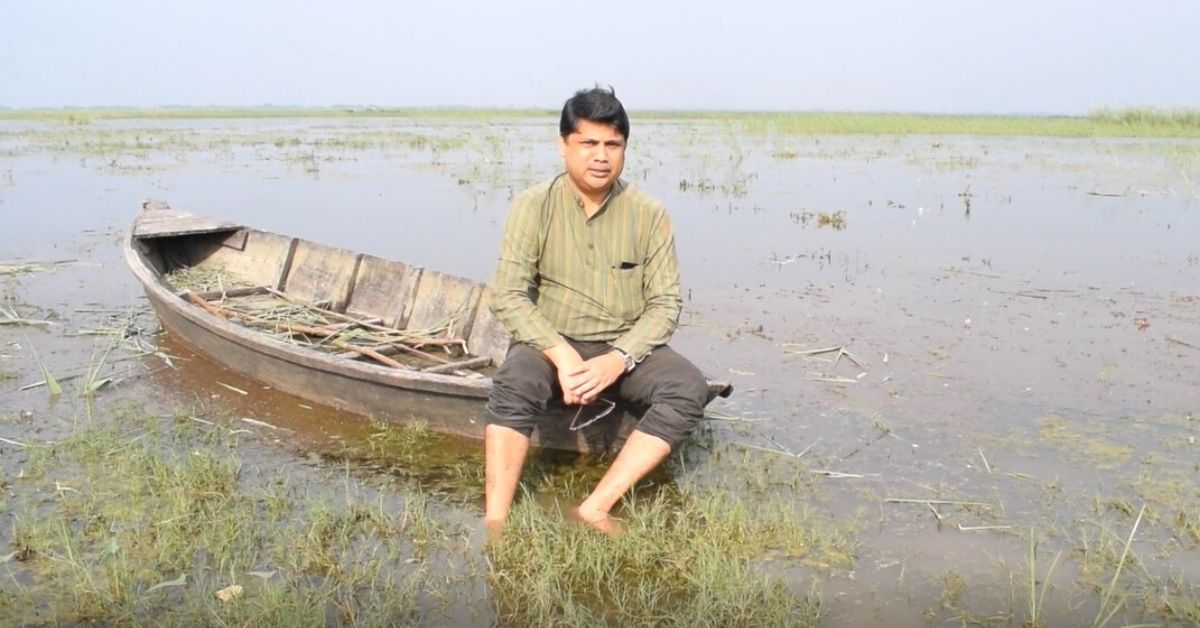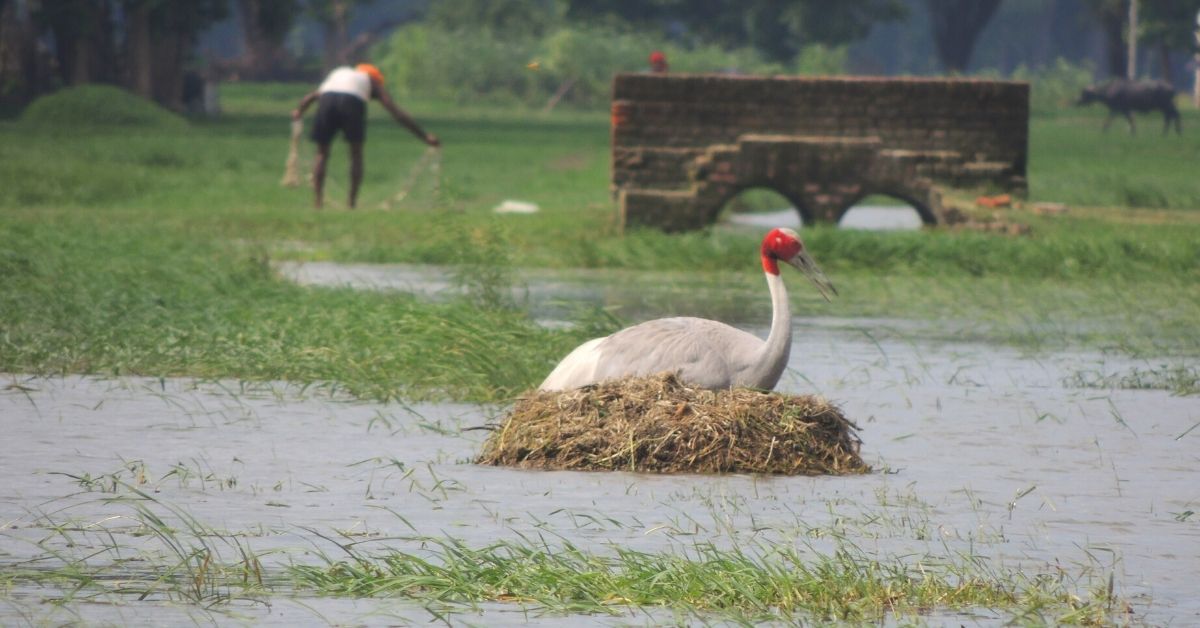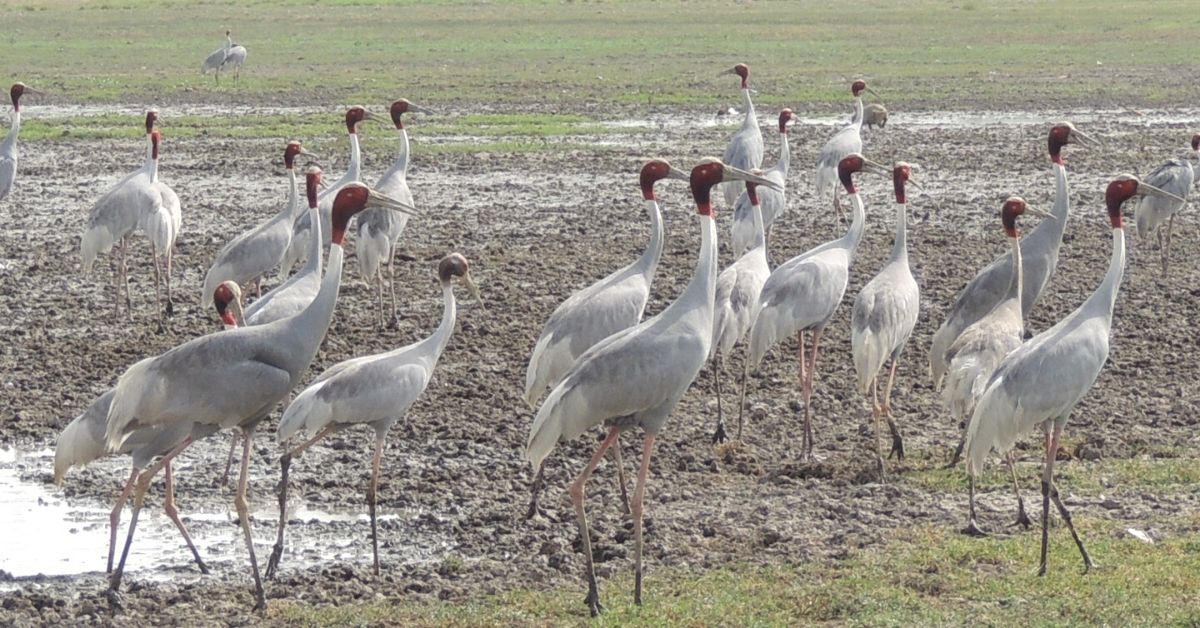50 Wetlands, 14000 Farmers & 1 Hero: How Sarus Cranes Were Revived From the Brink
In the heart of Uttar Pradesh, Dr Samir Kumar Sinha toiled for eight long years to bring together 14000 farmers and revive the population of Sarus Cranes. And the result has been a resounding success

In 2012, wildlife conservationist Dr Samir Kumar Sinha learned that the sarus crane was facing multiple threats in eastern parts of Uttar Pradesh.
“The habitat of the non-migratory bird was shrinking, and the eggs were being destroyed or stolen even before they hatched. Similar information came from across 10 districts and 26 NGOs who were working closely with farmers to help them implement sustainable practices,” Dr Samir tells The Better India.
He says, “Sarus cranes usually build their nest on paddy farms. They use straws and grass from their surroundings to build shelter, which is usually about 2 meters in diameter. Farmers feared for their crops due to the birds’ presence, and began shooing them away. They were not doing this deliberately, but were unaware of the damage they were causing to the lives of the cranes.”
Dr Samir adds that the exact population of the bird in the area was unknown, and it was vital to understand their numbers if any conservation practices were to be implemented. The damage caused due to loss of eggs had also been undocumented, which made the species vulnerable.

So in 2013, Dr Samir reached out to 40 farmers across Bahraich, Balrampur, Barabanki, Faizabad, Kushinagar, Maharajganj, Sant Kabir Nagar, Shrawasti, Shahjahanpur, and Siddhartha Naga in eastern Uttar Pradesh to identify the existing and potential threats to the cranes, and implement conservation measures accordingly.
A community effort
Dr Samir, who works as the head of conservation at Wildlife Trust of India, says the 2013 survey showed there were about 700 birds in ten districts, and that their population was dwindling.
“The survey also showed that the birds were facing threats due to electrocution by power supply lines and attacks by free-range dogs. Farmers using pesticides and herbicides on their farms and surrounding wetlands also affected the birds’ health due to food poisoning.”
He adds that analysing the data from the study further showed that the bird chose farmlands closer to the vicinity of wetlands to access food. “So we decided to rope in farmers from areas and explained to them the ecological importance of the bird. Sarus cranes have cultural and mythological significance, and we decided to draw the conservation narrative around it,” he explains.
Dr Samir says farmers were taught about the lifestyle, habits and other behavioural characteristics of the sarus crane. “They learned that birds nest around May-June, before the beginning of monsoon and leave the nests with chicks for the wetlands by December. So focus on protection was put during these months of the year.”
To involve more locals in the conservation process, Dr Samir formed Saras Mitra Society and Saras Mitras, which are village level institutions and volunteers who could monitor and ensure on-ground execution of the conservation process. “It became a platform for locals to connect and discuss the issues and steps to be taken to save the birds,” he says.

Dr Samir eventually sought support from the Uttar Pradesh forest department, local Krishi Vigyan Kendra and grassroots level NGOs. The project also received monetary support from World Land Trust and Tata Trust.
Yogendra Kanaujia, a volunteer from Maharajganj, says, “Birds smaller than sarus cranes have disappeared from the region, and the locals fear they are locally extinct. But we do not want the same fate for the sarus crane, as it is our state bird and our pride.”
The 27-year-old farmer says the bird also stops pests and insects from attacking the crops, which benefits the farms. “We practice organic farming to prevent poisoning for the birds,” he says.
Meanwhile, Dr Samir says that other than training farmers, workshops and visits for school students were also held to create awareness and involve them in the conservation effort. “The combined network at multiple levels — farmers, locals and students — helped us monitor any incidents of electrocution or injuries to the birds and intervene immediately,” he adds.
He says, “Around 2017-18, we learned that apart from protecting the bird nests on farms, wetland protection was equally important as sarus cranes depend on water bodies for food. Meanwhile, the wetlands are important for locals for aquaculture and growing water chestnuts. The spraying of chemicals for better growth of the fish affected the health of the sarus crane. Chemicals used on agricultural land would also drain into the wetlands.”
Dr Samir says that farmers were requested to switch to organic farming for this. “Moreover, we identified about 30 wetlands across the ten districts which were directly connected to the sustenance of sarus cranes and were shrinking due to anthropogenic activities and non-sustainable aquaculture practices,” he adds.
Dr Samir says a formal request has been made to the UP government to protect an additional 50 wetlands above 2.25 hectares area that play a significant role in serving as a habitat for the birds.
The collective efforts of over 14,000 villagers have helped increase the population of the sarus crane to more than 2,000 to date, Dr Samir says.
Sustainability is the key

Abhishek Singh, a forest ranger, says, “The combined intervention has helped revive the bird population. The conservation work has also impacted the food chain positively and restored the balance to some extent, as other species of birds and animals have also benefited from this.”
Meanwhile, Arshad Hussain, a sociologist with the WTI, says that despite the efforts, challenges continue to threaten the sarus crane population and consistent efforts are needed to ensure their survival.
“Apart from the loss of wetland habitat, the farmers are switching from paddy and wheat to growing sugarcane. Such farms are difficult for sarus cranes as they cannot see through them,” he says.
He adds that invasive species of fish introduced in wetlands also threaten their natural food sources. “Efforts are now being made to create awareness among fishermen and government officials to prevent the introduction of invasive fish species. Besides, convincing the villagers to use wetlands wisely for conservation is equally challenging. Protecting wetlands alone by stopping human activities does not serve the conservation purpose as the water body alone will grow into dense vegetation and die,” he says.
Arshad says wetlands need management through sustainable extraction of fish, vegetation and other resources as they serve as livelihood for locals. He adds that integrated management can only help bring success in changing mindset and preserving the species.
Dr Samir says that despite challenges, the conservation success cannot be accomplished without involving locals. “Participation of locals is a crucial aspect of conservation. It is primarily the human acumen, skills and willingness that can bring success,” he adds.
Edited by Divya Sethu
If you found our stories insightful, informative, or even just enjoyable, we invite you to consider making a voluntary payment to support the work we do at The Better India. Your contribution helps us continue producing quality content that educates, inspires, and drives positive change.
Choose one of the payment options below for your contribution-
By paying for the stories you value, you directly contribute to sustaining our efforts focused on making a difference in the world. Together, let’s ensure that impactful stories continue to be told and shared, enriching lives and communities alike.
Thank you for your support. Here are some frequently asked questions you might find helpful to know why you are contributing?


This story made me
- 97
- 121
- 89
- 167










